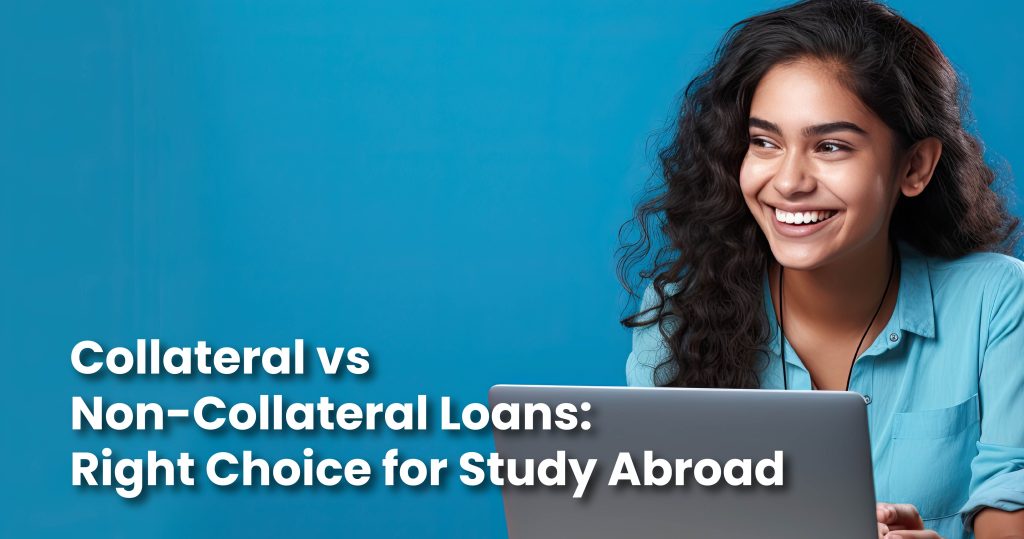Introduction
Every year, thousands of Indian students head abroad chasing world-class education and better career prospects. But before the dream takes off, there’s one major roadblock—financing. Tuition, living expenses, and visa requirements add up quickly, and most families turn to education loans to bridge the gap.
The big question students and parents face is: Should we choose a collateral loan or go for a non-collateral one? Both options sound promising, but they work in very different ways. Pick the wrong one, and you might end up with higher costs, visa delays, or even a rejected loan application.
In this article, we’ll break down what each type of loan means, the pros and cons of both, and how to decide which path is right for your study abroad journey.
What Is a Collateral Education Loan?
A collateral education loan, often called a secured education loan, is backed by an asset you or your family pledges to the bank. This asset works as security for the loan and lowers the lender’s risk.
Examples of collateral used:
- Residential or commercial property
- Fixed deposits (FDs)
- Life insurance policies
- Government bonds
Key features:
- Loan amounts are generally higher (sometimes ₹1 crore+ for top universities).
- Interest rates are usually lower compared to non-collateral loans.
- Approval rates are higher because the lender has security.
- The process takes longer due to property/legal verification.
When it makes sense:
If your family owns property or high-value assets and you’re aiming for a long course abroad (like an MBA or medical program), a collateral loan is often the cheaper and safer bet.
What Is a Non-Collateral Education Loan?
A non-collateral education loan, also known as an unsecured loan, doesn’t require you or your family to pledge any asset. Instead, the approval depends on your profile, your co-applicant’s income, and the credibility of the university and course you’ve chosen.
Who offers these loans?
- Private banks
- NBFCs (Non-Banking Financial Companies)
- Specialized fintech lenders
Key features:
- Loan amounts are generally capped (₹20–₹40 lakh for most NBFCs).
- Interest rates are higher compared to collateral loans.
- Processing is much faster since there’s no property/legal verification.
- Approval depends heavily on your co-applicant’s financial stability and your academic track record.
When it makes sense:
If you don’t own property, need money quickly, or are applying for a course with lower overall expenses, a non-collateral loan is usually the better fit. It’s especially helpful for students racing against intake deadlines.
Key Differences Between Collateral and Non-Collateral Loans
Choosing between collateral and non-collateral loans isn’t just about interest rates. Each option works differently in terms of risk, process, and acceptance by embassies.
| Factor | Collateral Loan (Secured) | Non-Collateral Loan (Unsecured) |
| Security Required | Yes — property, FD, insurance, or bonds | No security required |
| Loan Amount | Higher (up to ₹1 crore or more) | Lower (usually ₹20–₹40 lakh) |
| Interest Rate | Lower, typically 8–10% | Higher, typically 11–14% |
| Processing Time | Longer (legal + property checks) | Faster (no collateral checks) |
| Approval Chances | Higher (asset-backed) | Dependent on co-applicant income & credit |
| Risk Factor | Risk of losing pledged asset | No asset risk, but higher EMI burden |
| Acceptance for Visa | Universally accepted | Depends on country & lender (NBFC scrutiny in some cases) |
| Best For | High-cost courses, long-duration programs | Quick funding, smaller loan needs |
Pros and Cons of Collateral Loans
Collateral loans offer stability, but they come with trade-offs. Here’s a closer look:
Pros:
- Higher Loan Amounts: Banks are more willing to sanction large sums (₹50 lakh–₹1 crore+) when security is pledged.
- Lower Interest Rates: Rates are often 2–4% cheaper than unsecured loans, reducing your repayment burden.
- Better Visa Acceptance: Since collateral loans usually come from major banks, embassies view them as stronger proof of funds.
- Higher Approval Chances: Assets reduce the lender’s risk, so applications are less likely to be rejected.
Cons:
- Risk to Assets: If repayments fail, the pledged property or deposit can be seized.
- Longer Processing: Legal checks, property valuation, and documentation slow down the approval timeline.
- Family Dependency: You rely heavily on family assets, which may not always be feasible.
- Limited Flexibility: Once pledged, the asset is locked until the loan is repaid.
Pros and Cons of Non-Collateral Loans
Non-collateral loans are attractive for students who don’t have property to pledge, but they come with their own set of advantages and challenges.
Pros:
- No Security Required: You don’t need to pledge property, FDs, or other assets.
- Faster Processing: Since no collateral verification is involved, approval can take as little as a week.
- Accessible for More Students: Ideal for families without high-value assets.
- Flexibility: Useful for covering smaller or immediate funding needs.
Cons:
- Lower Loan Amounts: Typically capped at ₹20–₹40 lakh, which may not cover high-cost programs.
- Higher Interest Rates: Often 11–14%, leading to bigger EMIs.
- Strict Eligibility Checks: Lenders put more weight on your co-applicant’s income and your academic record.
- Visa Acceptance Issues: Some embassies scrutinize NBFC loans more closely, which may cause delays.
Which Loan Is Accepted for Student Visa?
When you’re applying for a student visa, showing proof of funds is non-negotiable. But not every type of loan is treated equally by embassies.
Collateral Loans (Secured):
- Widely accepted across countries since they’re usually issued by major public and private banks.
- Embassies consider them stable proof of long-term financial ability.
Non-Collateral Loans (Unsecured):
- Accepted in many cases, but with conditions.
- Some embassies are cautious if the loan is from an NBFC or smaller private lender.
- For example:
- Canada: Often prefers loans from scheduled banks, though NBFC loans can work with proper documentation.
- Germany: Blocked account is mandatory, but an education loan can supplement.
- UK/USA: More flexible, but embassy officers may ask for additional evidence of repayment ability.
- Canada: Often prefers loans from scheduled banks, though NBFC loans can work with proper documentation.
Pro tip: Always confirm with the visa consultant or embassy guidelines whether your loan provider’s sanction letter will be accepted as financial proof.
How to Decide Which Loan Fits You
Choosing between collateral and non-collateral loans depends on your family’s financial situation, the urgency of your application, and the cost of your chosen program. Here’s a quick checklist to guide you:
Ask yourself:
- Do I have property or deposits to pledge?
- How quickly do I need the loan approved?
- What’s the total cost of my course and living expenses?
- Is my co-applicant’s income strong enough to support a non-collateral loan?
- Will my loan type be accepted by the embassy for proof of funds?
Example Scenarios:
- Student A: Applying for a 2-year Master’s in the USA with tuition fees of ₹60 lakh+. Parents own a house. → Collateral loan makes more sense due to higher amount and lower rates.
- Student B: Applying for a 1-year PG diploma in the UK with tuition + living expenses of ₹20 lakh. No property available, deadline in 2 weeks. → Non-collateral loan is the better choice for speed and flexibility.
Expert Tips to Improve Your Loan Approval Chances
Even if you’ve chosen the right type of loan, weak preparation can lead to delays or rejection. Here are some smart moves to strengthen your application:
1. Organize Your Documents Early
- Keep property papers, admission letters, bank statements, and ID proofs ready.
- Incomplete files are one of the biggest reasons for loan delays.
2. Strengthen Your Credit Profile
- A CIBIL score of 700+ improves your chances.
- If your score is low, add a co-applicant with a strong credit history.
3. Show a Clear Financial Plan
- Break down tuition, living, travel, and insurance costs.
- Lenders prefer students with well-documented budgets.
4. Choose the Right Co-Applicant
- Parents/guardians with stable income and low debt increase approval chances.
- Add a secondary co-applicant if needed.
5. Compare Multiple Lenders
- Don’t settle for the first option.
- Check terms across public banks, private banks, and NBFCs — processing times and visa acceptance vary.
6. Apply Early
- Loan processing takes time, especially for collateral loans.
- Apply 3–4 months before your intake to avoid last-minute stress.
How Finnest Helps Students
Figuring out whether to go for a collateral or non-collateral loan is stressful when deadlines are close and embassies demand precise financial proof. That’s where Finnest.in steps in.
What they do differently:
- Profile-Based Loan Guidance: They assess your academic, financial, and visa needs to suggest the right type of loan.
- Access to Multiple Lenders: From public banks to NBFCs, they connect you with options that fit your situation.
- Faster Approvals: Their consultants know how to avoid common documentation mistakes that delay processing.
- Visa-Ready Loan Letters: They make sure your sanction letter is accepted as proof of funds for embassy requirements.
- Show Money Assistance: For urgent cases, they arrange compliant financial proof to help students meet visa requirements.
In short, Finnest doesn’t just help you borrow — they make sure your finances align with embassy standards, so your dream of studying abroad isn’t blocked by paperwork.
Conclusion
Financing your study abroad journey doesn’t have to be overwhelming. Both collateral and non-collateral loans are useful — the right choice depends on your family’s financial standing, urgency, and long-term repayment comfort.
If you have assets to pledge and need a large loan with lower interest, collateral loans are often the smarter bet. If you’re racing against deadlines or don’t have property, non-collateral loans give you speed and flexibility.
At the end of the day, the best option is the one that gets your visa approved smoothly and supports your academic goals. With expert guidance from Finnest.in, you won’t have to guess — you’ll have a clear financial plan that works for both your dream university and embassy requirements.
FAQs
1. Which loan is better for Canada student visa?
Collateral loans from recognized banks are preferred, but NBFC loans are accepted with proper sanction letters.
2. Can I get a study loan without collateral if my parents don’t own property?
Yes, many NBFCs and private banks offer loans up to ₹40 lakh without security.
3. What is the maximum amount for a non-collateral education loan?
Usually between ₹20–₹40 lakh, depending on your profile and lender.
4. Does every embassy accept NBFC loans?
Not always. Some embassies, like Germany, are stricter. Always confirm before applying.
5. How fast can I get a collateral loan compared to a non-collateral loan?
Collateral loans can take 3–4 weeks due to property checks. Non-collateral loans may be approved in 7–10 days.




